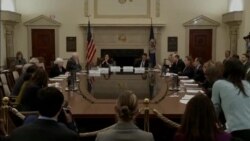The U.S. central bank signaled Wednesday that the job market will have to improve further and inflation will have to rise a bit before it raises interest rates from record lows.
U.S. Federal Reserve Chair Janet Yellen told journalists that a rate hike could come later this year, but only if economic data indicated the time was right.
After wrapping up a two-day meeting, Fed policymakers said an increase was "unlikely" at their next meeting in April, but they dropped a pledge to be "patient" in deciding when to begin raising rates. They also lowered their forecast for economic growth and noted that inflation would most likely remain low.
The Fed has kept its key short-term rate nearly at zero since late 2008 to help the economy recover from the financial crisis and recession. A rate increase would push up consumer and business rates.
The Fed’s job is to encourage full employment and stable prices in the economy. But millions of people are working part time because they cannot find full-time work, and inflation is running below the 2 percent rate that many analysts think is healthy for the economy. Waiting too long to raise rates, they contend, might spark higher inflation that could hurt the economy.
Officials reduced their estimate of the unemployment rate that they think is consistent with a healthy economy to a range of 5 percent to 5.2 percent. That's down from a previous range of 5.2 percent to 5.5 percent. The current rate is 5.5 percent.
In characterizing the economy, the Fed noted that export growth had weakened. Part of this was due to the strength of the dollar, which has made U.S. products cost more abroad.
The Fed pared its forecasts for the economy, cutting its growth estimate for the year to a range of 2.3 percent to 2.7 percent. In its last forecast, issued in December, the range was 2.6 percent to 2.7 percent. The change was an acknowledgement that some important economic indicators have been weaker than expected recently.
The Fed report, more dovish about interest rates than investors had expected, pushed market bets on the central bank's timing of a rate hike from midyear to the fall. Stocks on Wall Street surged and oil prices jumped as much as 5 percent after the Fed statement. The dollar tumbled against other major currencies, and the U.S. 10-year Treasury yield dipped below 2 percent for the first time since March 2.
Some information for this report came from AP and Reuters.









